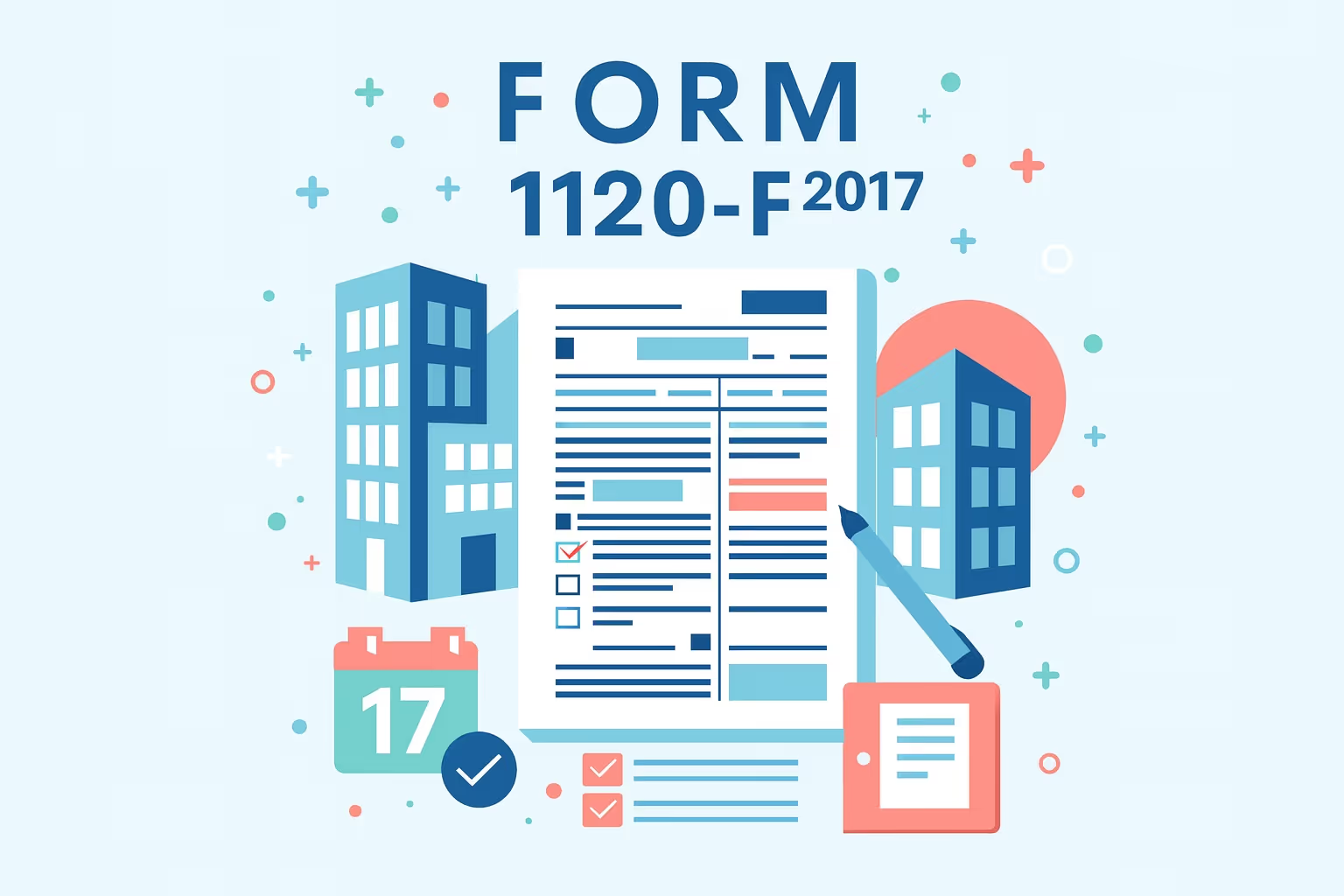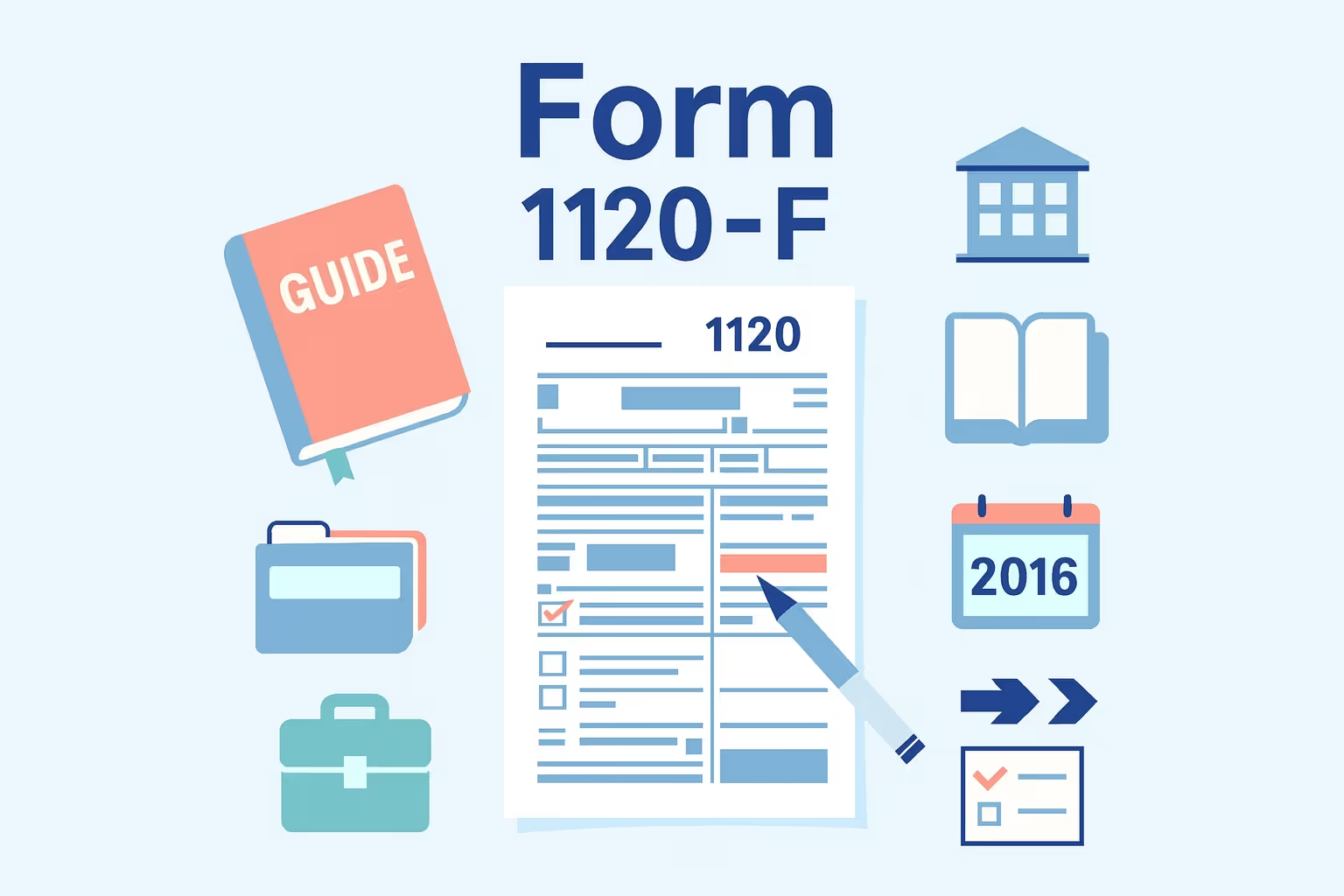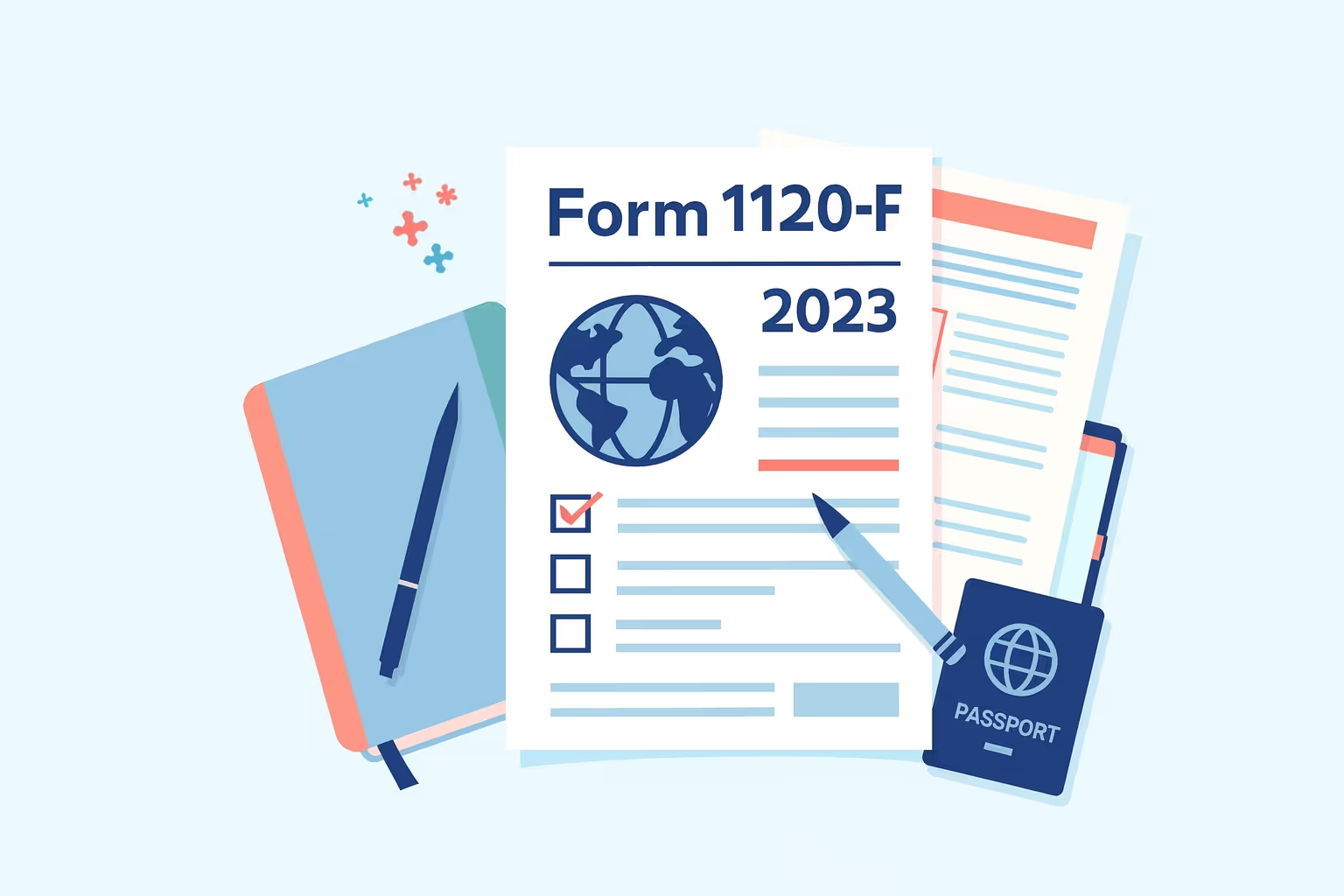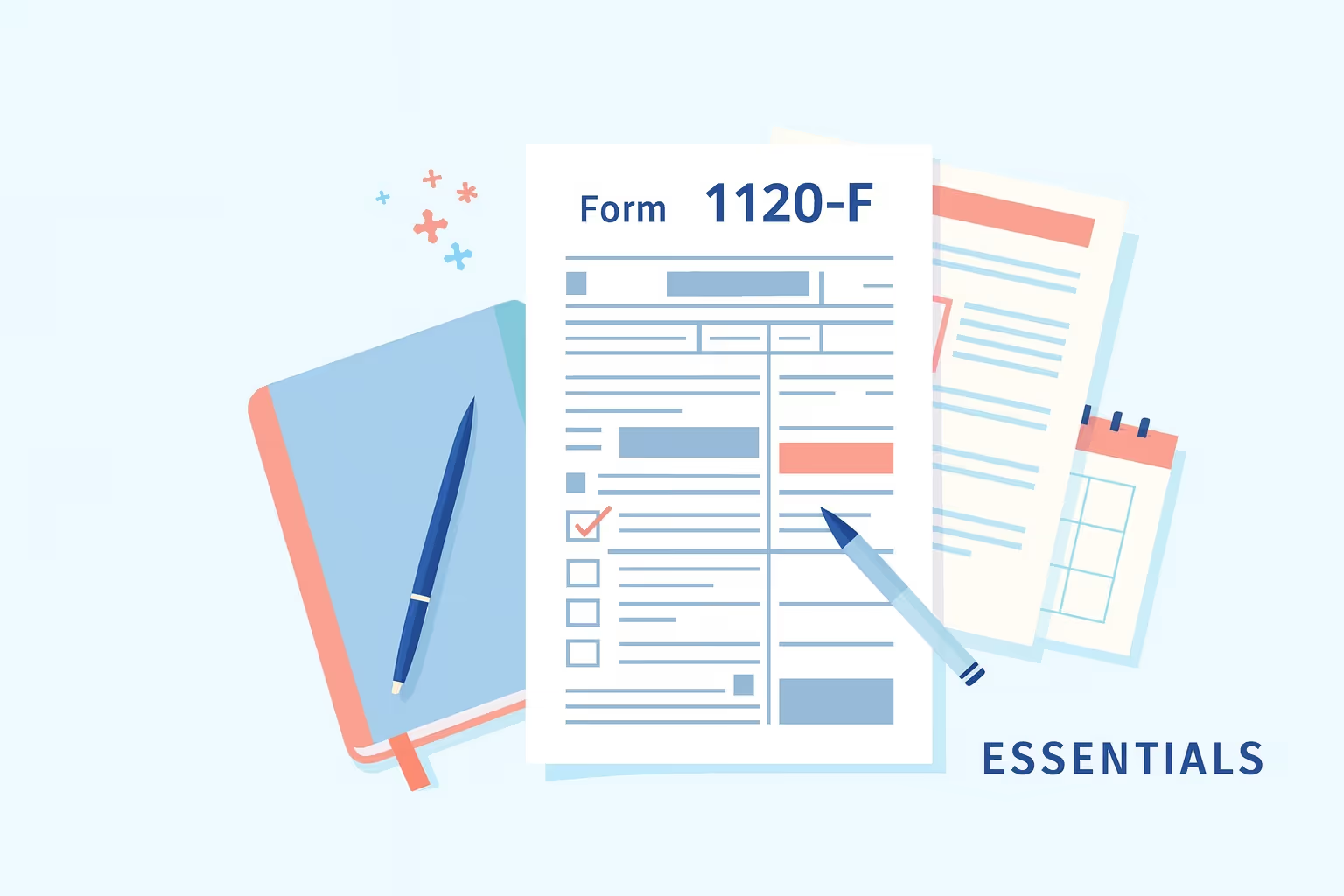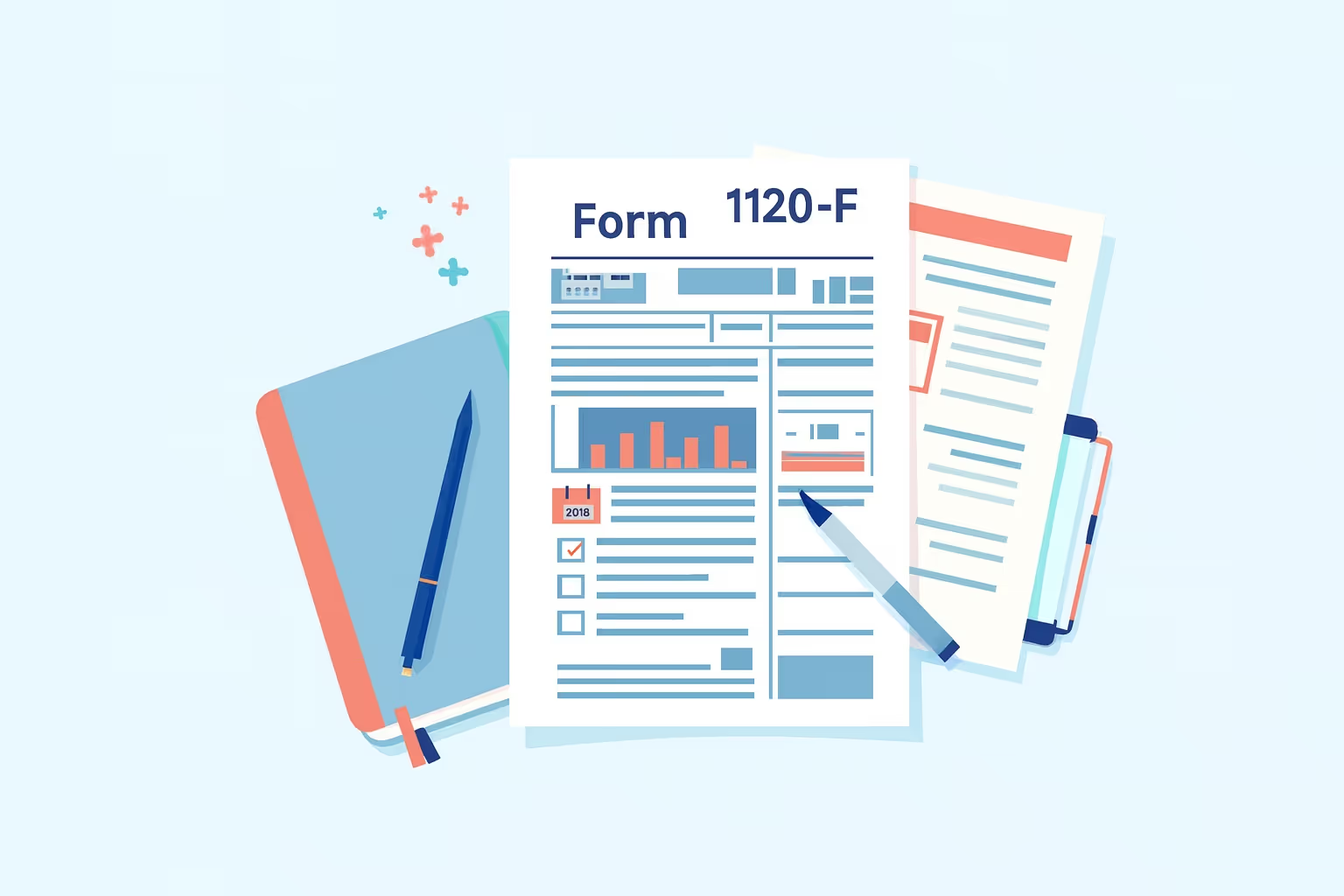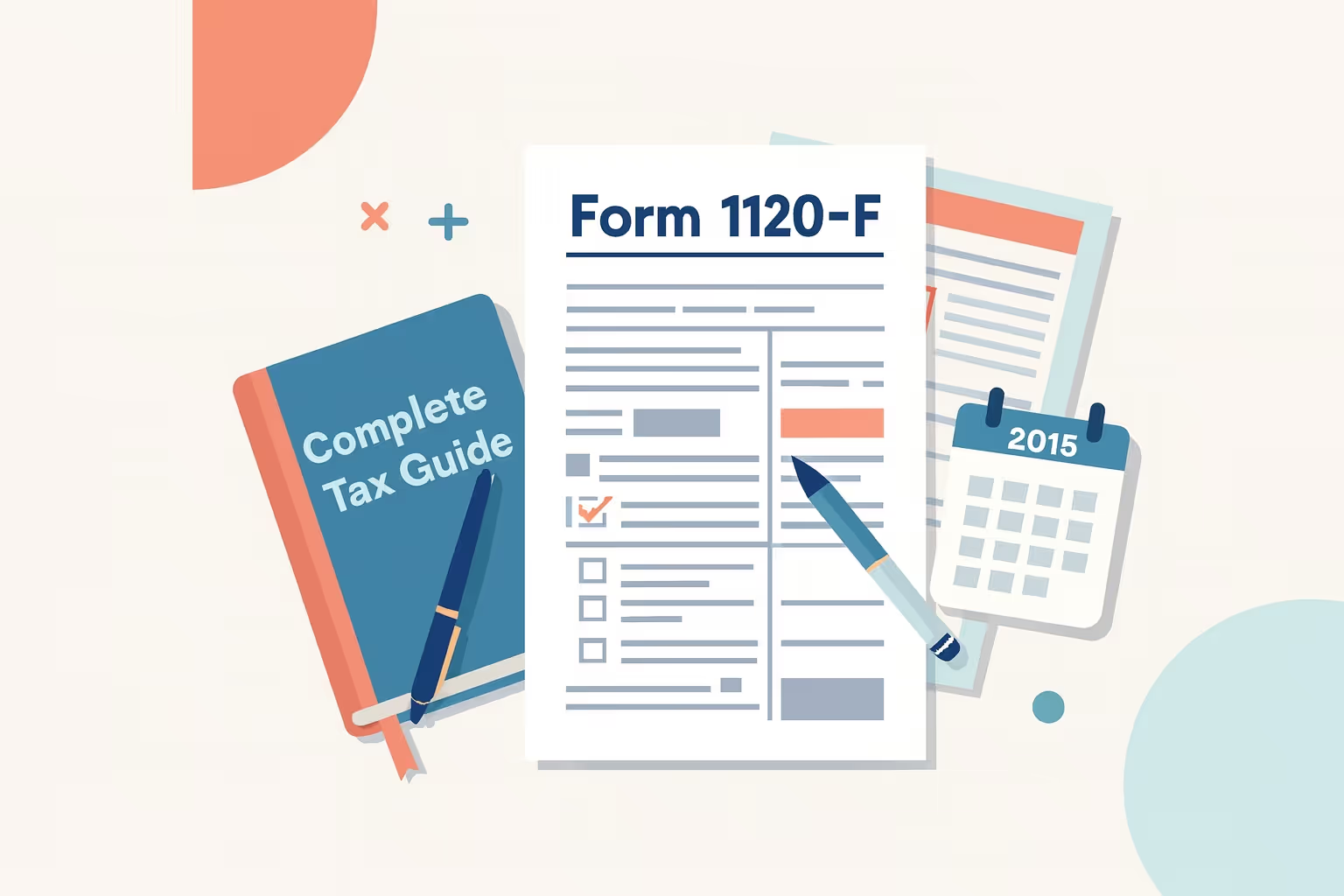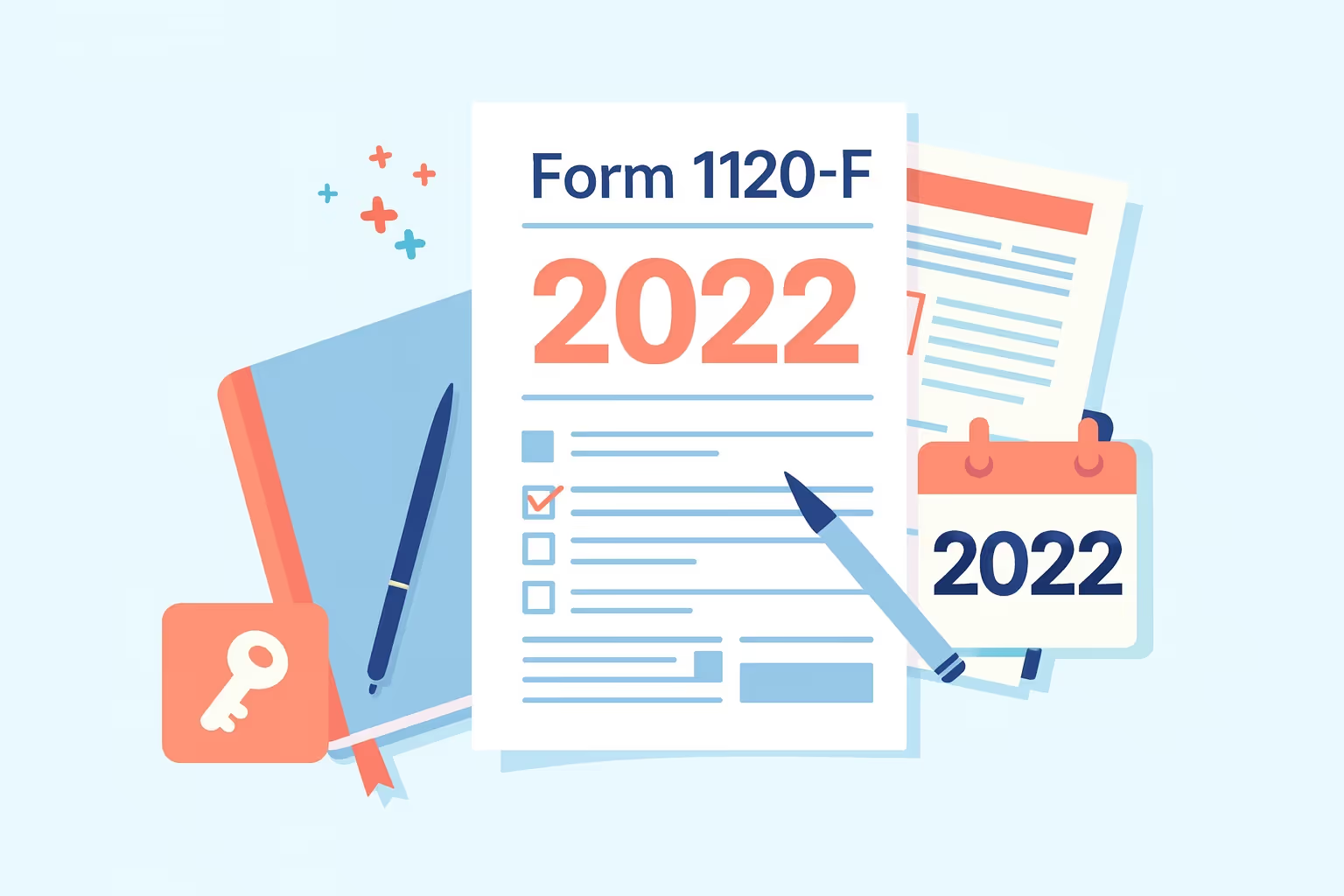
IRS Form 1120-F is the U.S. income tax return filed by a foreign corporation that has business activities or effectively connected income in the United States. For the 2013 tax year, the form served as the official record to report gross income, deductions, and tax liability connected to U.S. operations. Even if no taxable income is reported, certain corporations are still required to file to claim refunds of withholding tax or to meet compliance requirements.
This filing is crucial for companies incorporated initially in a foreign country that are engaged in a U.S. trade or business. The form ensures proper calculation of net income, recognition of capital gains, and accurate application of tax treaties that may reduce withholding or branch profits tax. It also provides a structured way for corporations to claim a tax credit for foreign taxes paid, allocate expenses such as wages and interest, and comply with U.S. rules regarding the reporting of taxable income.
Filing Form 1120-F for 2013 required careful attention to deadlines, payment procedures, and documentation. Corporations were required to file by the original due date, unless an extension was requested; late filings could result in penalties or the permanent loss of deductions. For many corporations operating in multiple jurisdictions, the form also clarified how income, capital assets, and deductions were treated for U.S. tax purposes. By following the official 2013 instructions, foreign taxpayers could meet their filing obligations and avoid compliance issues with the IRS.
What Is IRS Form 1120-F?
IRS Form 1120-F is the U.S. Income Tax Return of a Foreign Corporation. It applies to corporations incorporated initially in a foreign country but engaged in business activities in the United States. The form documents gross income, deductions, and taxable income, while also calculating income taxes owed. It ensures compliance with U.S. tax law, even when a corporation claims a treaty exemption or expects a refund of withholding tax.
Who Must File Form 1120-F?
A foreign corporation is required to file Form 1120-F under several circumstances that demonstrate business involvement in the United States:
- A corporation must file if it was engaged in a trade or business within the United States at any time during the tax year, regardless of whether it earned a profit.
- Filing is required when the corporation earned effectively connected income that is subject to U.S. tax, even if that income is later reduced through deductions or tax treaties.
- A corporation must file if it received U.S. source income that was not fully covered by withholding tax at the time of payment.
- Filing is necessary when the corporation intends to claim deductions, apply a tax credit, or request a refund for foreign tax already paid.
- A corporation must also file if it was a beneficiary of an estate or trust that was engaged in a U.S. trade or business during the tax year.
Exceptions From Filing
Certain foreign corporations are not required to file Form 1120-F when their U.S. connections are limited:
- A return is not required when the corporation had no U.S. trade or business during the tax year and all income taxes were entirely withheld at the source of income.
- Corporations are exempt from filing if their only U.S. source income was exempt under section 881(c) or section 881(d), such as certain types of portfolio interest or specific qualified income.
- Filing is not required when the corporation does not intend to claim deductions, refunds, or treaty-based benefits from the IRS.
In practice, submitting Form 1120-F allows corporations to safeguard valuable deduction rights, properly document treaty positions, and reduce the risk of penalties. For companies conducting business in multiple jurisdictions, the form also creates a consistent framework for reporting how income, capital gains, and other items are treated for U.S. purposes.
Key Filing Rules for Tax Year 2013
For the 2013 tax year, the Internal Revenue Service maintained most of the requirements for Form 1120-F, but issued reminders that foreign corporations needed to pay close attention to. The filing rules addressed deadlines, mandatory e-filing requirements, and proper allocation of deductions.
- Corporations with a U.S. office were required to file Form 1120-F by the fifteenth day of the third month after the close of the tax year. For most calendar-year filers, this date was March 15, 2014.
- Corporations without a U.S. office were given until the fifteenth day of the sixth month after the close of the tax year. For calendar-year filers, this deadline was June 15, 2014.
- If a filing deadline fell on a Saturday, Sunday, or legal holiday, the due date automatically shifted to the next business day.
- Corporations with $10 million or more in assets and that filed 250 or more returns were required to file electronically. This rule aimed to improve accuracy and speed up IRS processing.
- The IRS emphasized that corporations must properly allocate deductions under regulations sections 1.861-8 and 1.882-5. Incorrect allocation could lead to disallowed deductions and higher tax liability.
These filing rules underscore the importance of adhering to deadlines and maintaining proper reporting. Failure to comply could result in penalties, lost deductions, or delays in receiving refunds.
Step-by-Step Instructions for Completing Form 1120-F
Completing Form 1120-F requires attention to detail and accurate reporting. Each step of the process ensures that foreign corporations comply with IRS requirements and accurately calculate their tax liability.
Step 1 – Gather Required Information.
Before starting the form, corporations must have all necessary documentation available. This includes a valid U.S. Employer Identification Number, financial statements for U.S. operations, Forms 1042-S showing withholding tax, any applicable partnership Schedules K-1, treaty-related certifications, and the prior year’s return for reference. Having these records ensures that income and deductions can be verified if requested by the IRS.
Step 2 – Complete Page 1 (Basic Information).
Page 1 requires corporations to provide their official name, current address, EIN, and the beginning and ending dates of the tax year. This information must be accurate and match the records used for tax purposes. Corporations must also indicate whether they are filing on a calendar year or a fiscal year basis.
Step 3 – Complete Page 2 (Additional Information).
Page 2 contains a series of questions designed to confirm the corporation’s U.S. presence and activities. Corporations must disclose their country of incorporation, the nature of their trade or business, and any transactions with related parties. If treaty-based return positions are claimed, the corporation must also attach Form 8833 to support its filing.
Step 4 – Report Non-Effectively Connected Income (Section I).
This section covers income that is not directly tied to a U.S. trade or business. Examples include dividends from U.S. corporations, certain types of interest, and rents or royalties from real estate. This type of income is generally taxed at a flat withholding rate unless a tax treaty provides a lower rate.
Step 5 – Report Effectively Connected Income (Section II).
Section II is the core of the return for most filers. Corporations must report all income connected with U.S. operations, such as sales revenue, gains from capital assets, and rental income from real property. Deductions, including wages, charitable contributions, and interest expense, are subtracted from gross income to calculate net income and ultimately taxable income.
Step 6 – Calculate Branch Profits Tax (Section III).
Section III requires corporations to calculate the branch profits tax, which is generally 30 percent of effectively connected earnings and profits not reinvested in U.S. operations. However, a tax treaty may allow a reduced rate. Corporations must adjust this calculation by considering changes in U.S. net equity. Incorrect reporting here can result in excess payments or IRS disputes.
By following these steps carefully, corporations can ensure that their tax return accurately reflects their income, deductions, and tax treatment. Proper documentation reduces the likelihood of errors and helps protect against penalties and fines.
Filing Methods and Deadlines
Foreign corporations filing Form 1120-F for 2013 could submit returns either electronically or on paper, depending on their eligibility. Understanding both methods and the associated deadlines was critical for maintaining compliance.
- Electronic filing was mandatory for corporations with assets of $10 million or more and that filed 250 or more returns. Corporations using this method had to work with an authorized IRS e-file provider, complete the form electronically, attach all required schedules, and sign electronically.
- Paper filing was still permitted for smaller corporations. In this case, the completed form and payment were mailed to the IRS Service Center in Ogden, Utah. Corporations that use private delivery services such as FedEx or UPS are required to confirm the correct physical address on IRS.gov.
- For corporations with a U.S. office, the deadline was the fifteenth day of the third month after the end of the tax year, which was March 15, 2014, for calendar-year filers.
- For corporations without a U.S. office, the deadline was the fifteenth day of the sixth month after the end of the tax year, which was June 15, 2014, for calendar-year filers.
- When a due date fell on a weekend or legal holiday, the return could be filed on the next business day without penalty.
- Extensions were available by filing Form 7004 by the original due date, which allowed for an additional six months to submit the return. However, extensions applied only to filing, not to payment. Any income taxes owed were still due by the original deadline.
By choosing the correct filing method and meeting the proper deadlines, corporations ensured the timely submission of their returns and avoided unnecessary penalties or interest.
Payment Instructions
Foreign corporations were required to pay any income taxes due by the original filing deadline, even if they requested an extension to file the return. Several payment options were available, depending on whether the corporation maintained a U.S. office or bank account.
- Corporations filing electronically could use electronic funds withdrawal, which allowed the IRS to debit a designated U.S. bank account on the due date. This option was convenient for filers who already used e-file.
- The Electronic Federal Tax Payment System (EFTPS) offered an additional option. This system required enrollment, which could take up to 10 business days to complete. Once approved, taxpayers could schedule payments online or by phone.
- Corporations without access to a U.S. bank account often relied on third-party arrangements to manage their financial transactions. These could include financial institutions, intermediaries, or trusted business partners making the payment on their behalf.
- Paper filers could send a check or money order payable to the United States Treasury, ensuring that the corporation’s name, EIN, and “Form 1120-F” appeared on the memo line. Payments had to be mailed with the return to the IRS Service Center in Ogden, Utah.
- Estimated tax payments were required if the total expected liability exceeded $500 for the year. These payments were made quarterly, in the fourth, sixth, ninth, and twelfth months of the fiscal year.
Meeting payment obligations on time prevented penalties and interest. Corporations that carefully tracked due dates, especially across multiple jurisdictions, could manage cash flow more effectively and maintain compliance with IRS rules.
Required Schedules and Attachments
The IRS required foreign corporations to attach specific schedules and supporting forms to ensure accurate reporting of income, deductions, and tax treatment. Each attachment served a distinct purpose in clarifying how items were allocated and calculated.
- Schedule H was required when deductions were reported for effectively connected income. This schedule allocated and apportioned deductions, ensuring they were matched correctly to U.S. income.
- Schedule I applies when a corporation has interest expenses that need to be allocated under Section 1.882-5. Even if the interest was not deductible in the current year, this schedule was required for proper reporting.
- Schedule P was required for corporations with partnership interests that generated effectively connected income. It reconciled partnership activity with the foreign corporation’s return.
- Schedule M-1 was required for all filers to reconcile book income with tax income. Large corporations with assets of $10 million or more were required to file Schedule M-3, which provided more detailed information.
- Conditional schedules, such as Schedule V for vessel or aircraft income and Schedule S for corporations claiming an exemption under section 883, applied depending on the corporation’s activities.
- Form 8833 had to be attached whenever a corporation claimed treaty benefits that overrode U.S. tax rules. This ensured transparency in the use of tax treaties.
The IRS requires schedules and attachments to be assembled in a specific order, starting with credits, followed by schedules, and concluding with supporting statements and certifications. Corporations that followed the order carefully avoided processing delays and ensured the IRS could review all required information efficiently.
Common Mistakes to Avoid
Filing Form 1120-F for 2013 involved detailed requirements, and even minor mistakes could create significant problems. Foreign corporations needed to be aware of the most frequent errors to avoid costly outcomes.
- Filing late was a standard error. If a corporation submitted Form 1120-F after the 18-month limit, it permanently lost the ability to claim deductions and credits against effectively connected income.
- Many corporations failed to attach required schedules such as H, I, or P. Missing schedules could cause the IRS to reject deductions or consider the return incomplete.
- Using the wrong EIN or failing to obtain the proper signature from an authorized officer often led to return rejections or delays in processing.
- Treaty documentation errors were also frequent. Corporations that claimed treaty benefits without filing Form 8833 or without adequate supporting statements often had those benefits denied.
- Misallocations of deductions, particularly under sections 1.861-8 and 1.882-5, led to disallowed claims and increased tax liability.
- Errors in calculating the branch profits tax frequently arose from incorrect computations of effectively connected earnings and profits or misapplication of treaty rates.
By understanding these pitfalls, corporations could review their returns more carefully before filing. Taking extra steps to verify signatures, schedules, and calculations significantly reduced the risk of rejection, penalties, or excess payments.
The IRS uses this filing to confirm whether deductions, treaty positions, or refunds apply, even if there is no taxable income.
- A corporation had to file if it maintained any level of U.S. trade or business, even if it involved minimal consulting, advisory, or investment activities.
- Filing was also required if the corporation had U.S. source income that was not fully satisfied by withholding tax, such as dividends or interest.
- Protective returns were encouraged when corporations believed they had no effectively connected income but still wanted to preserve the right to claim deductions and credits if the IRS disagreed. A protective return required the full completion of Form 1120-F, along with an explanatory statement.
- A corporation was not required to file if it had no U.S. trade or business and all income had been entirely withheld at source. Similarly, if only U.S. income that was exempt under Section 881(c) or 881(d), no return was required.
Filing during dormant years helped corporations avoid the permanent loss of deductions. By submitting either a standard or protective return, foreign taxpayers ensured that if the IRS later determined that U.S. activities created effectively connected income, they would still retain the right to offset that income with deductions.
First-Time Filer Guidance
Corporations filing Form 1120-F for the first time often faced challenges due to the form’s complexity and detailed requirements. Following key steps early in the process made compliance more manageable.
- The first step was obtaining a U.S. Employer Identification Number (EIN). Foreign corporations could apply using Form SS-4 or by contacting the IRS directly. This number was required for all filings, payments, and correspondence.
- Corporations needed to confirm whether they had a filing obligation by assessing their U.S. trade or business activities, identifying effectively connected income, and reviewing applicable tax treaties.
- Sound record-keeping systems were critical. Corporations were required to maintain financial statements, Forms 1042-S for withholding tax, and documentation supporting deductions, such as wages, charitable contributions, or capital asset transactions.
- Understanding filing deadlines was essential. Corporations with a U.S. office generally filed by the fifteenth day of the third month, while those without a U.S. office filed by the fifteenth day of the sixth month. Late returns risked penalties and the loss of deduction rights.
- Many first-time filers benefited from professional assistance. Tax advisors provided support with treaty positions, allocation of deductions, and planning strategies, ensuring the return met IRS regulations.
By following these steps, new filers could navigate the process more effectively, establish compliance practices for future years, and minimize the risk of errors that might attract IRS scrutiny.
Understanding ECI vs. FDAP Income
A critical part of completing Form 1120-F is understanding the difference between effectively connected income (ECI) and fixed, determinable, annual, or periodical (FDAP) income. The IRS requires corporations to classify their income correctly, since the tax treatment of each category is very different.
- Effectively connected income is income that arises from conducting a trade or business in the United States, as defined by the Internal Revenue Code. It is taxed on a net income basis, which means corporations can reduce their gross income with allowable deductions, such as wages, interest, and charitable contributions.
Examples of ECI include sales revenue from U.S. operations, compensation for personal services performed in the United States, rental income from real property, and gains from the sale of capital assets connected with a U.S. business.
- FDAP income generally includes passive income that is not tied to active business activities in the United States. This type of income is taxed on a gross basis at a flat 30% rate, unless a tax treaty provides a lower treaty rate. Examples include dividends, certain types of interest, royalties, and rents not connected with a U.S. trade or business. Deductions are not permitted against FDAP income.
- Tax treaties play an essential role in determining whether income is classified as ECI or FDAP. For example, treaties may reduce withholding tax on FDAP income or limit U.S. taxation of business profits, provided the corporation does not have a permanent establishment in the country where taxation is imposed.
Accurate classification of income ensures that corporations report the correct taxable income, apply the proper withholding rates, and avoid disputes with the IRS. This distinction also affects how branch profits tax is calculated, making it a vital consideration for foreign corporations filing Form 1120-F.
Frequently Asked Questions
What are the instructions for Form 1120-F 2013?
The Form 1120-F 2013 instructions guide a foreign corporation through reporting gross income, deductions, and tax liability related to U.S. trade or business. These rules outline the procedures for classifying effectively connected income, FDAP income, and capital gains, as well as the application of tax treaties. Following IRS instructions helps ensure that the tax return is filed correctly and that corporations maintain compliance with the 2013 tax year.
How does a foreign corporation determine its tax liability?
A foreign corporation determines its tax liability by calculating taxable income from U.S. sources. Gross revenue from business activities, such as sales, rents, or real property transactions, is reduced by deductions for wages, charitable contributions, and interest expenses. Net income is then subject to graduated rates. Corporations must also consider withholding tax, branch profits tax, and adjustments for foreign tax credits when finalizing their total payment due.
How do tax treaties benefit foreign corporations?
Tax treaties between the United States and a foreign country offer advantages, including lower treaty rates on dividends, interest, and royalties. They also limit U.S. taxation of business profits unless a permanent establishment exists. For tax purposes, this means a parent corporation or parent company may avoid double taxation across multiple jurisdictions. To claim treaty benefits, a corporation must disclose the position and may need to attach Form 8833.
What is the difference between effectively connected income and FDAP income?
Effectively connected income is directly tied to U.S. business activities and is taxed on a net basis, allowing deductions for compensation, wages, and other business expenses. FDAP income includes dividends, interest, rents, or royalties and is subject to withholding tax on a gross basis with no deductions allowed. Understanding this tax treatment enables corporations to classify income correctly, calculate their tax liability accurately, and comply with IRS regulations for accurate reporting.
What should corporations know about due dates and legal holidays?
The original due date for filing depends on whether a corporation has a U.S. office or not. Those with an office must file by the fifteenth day of the third month, while those without an office file by the fifteenth day of the sixth month. If the due date falls on a legal holiday or weekend, the IRS allows filing on the next business day. Filing late may result in penalties and the loss of deductions.
Can deductions and net operating losses be applied to reduce taxable income?
Yes, foreign corporations may claim deductions such as charitable contributions, wages, or interest when calculating taxable income. They can also apply net operating losses from prior years to reduce current tax liability. Schedule D is used to report gains or losses from capital assets. These rules give corporations an advantage by ensuring their tax treatment reflects actual profit levels, preventing excess payments, and allowing refunds when overpaid.




















